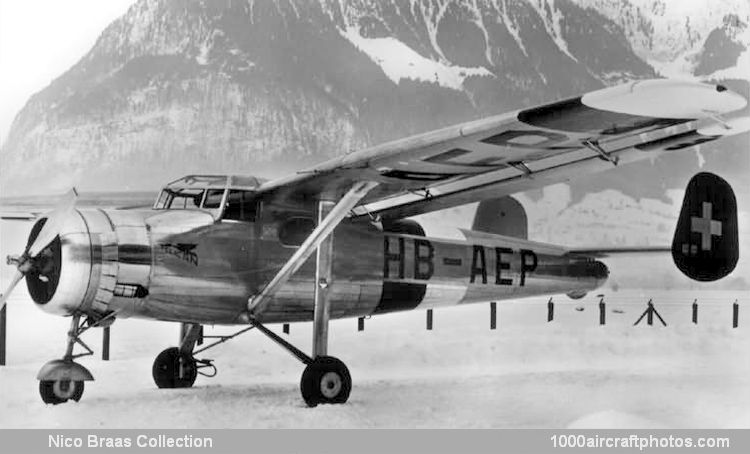During 1941 the Swiss government ordered Professor Eduard Amstutz of the Eidgenössische Technische Hochschule (ETH, Federal University of Technology) at Zürich, to develop a small STOL-transport ideal for the Swiss environment. At the ETH a Studienbüro (SB, study office) was formed, guided by Ingenieur Hans Belart, and the second design of the SB was proceeded with, hence the designation SB-2. After slow progress the completed design was eventually sold to Pilatus.
Registered HB-AEP the prototype SB-2 was first flown by Swissair Flugkapitän (Captain) Ernst Nyffeneggera from Stans on May 30, 1944. Although performing well the aircraft was not taken into series production as Pilatus capacity was already tied up to the production of their first own design, the P-2 trainer, of which 55 were produced. The SB-2 was subsequently sold to Alpar AG in Bern.
The flying career of the sole SB-2 ended on an air display at Kirchberg near Bern on June 13, 1948. Upon take off, an unmarked ditch in the grass field sheered-off the nose wheel and the aircraft overturned, HB-AEP being damaged beyond repair."
Type: Five-seat cabin monoplane.
Wings: High-wing braced monoplane. Forwardly-swept wings attached to roots built integrally with the fuselage roof and braced to the bottom of the fuselage by single struts. All-wood single-spar structure. Auto slots along entire leading edges of wings. Trailing edge flaps between ailerons and fuselage.
Fuselage: All-metal monocoque structure.
Tail unit: Cantilever monoplane type with twin fins and rudders.
Landing gear: Fixed tricycle-type. Main shock-absorber struts cantilevered from the apices of two rigid pyramids, each of which consists of a vertical strut attached at its upper end to the wing spar and a down-sloping 'V', the inner ends of which are attached to the lower sides of the fuselage. Cantilever nose wheel strut. Steerable nose wheel interconnected with the rudder control.
Power plant: One 450 hp Pratt & Whitney Wasp-Junior nine-cylinder air-cooled radial engine. Fuel tanks in wings.
Accommodation: Enclosed accommodation for crew of two and three passengers. Pilot's compartment forward of leading edge of wings. Passenger cabin beneath wings. Baggage compartment aft of cabin. Partition between cabin and baggage room may be removed to provide space for bulky freight, which can be loaded through a hatch in the floor.
